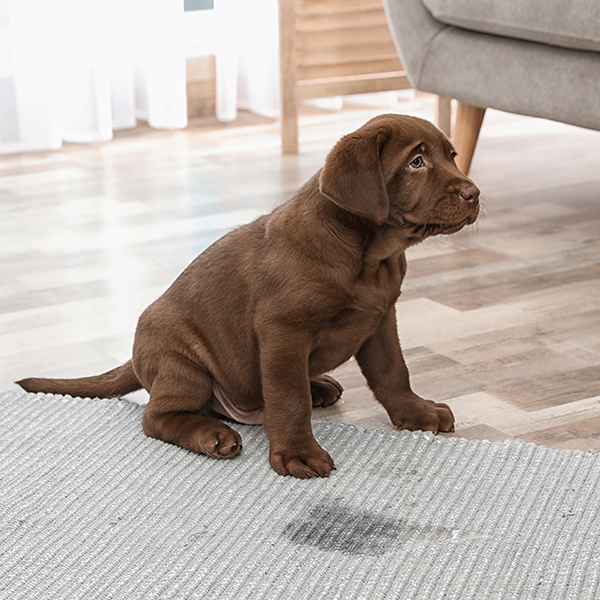Once it is done and over with, potty training your dog or puppy is one of the most relieving accomplishments to be made during your journey of dog ownership. Some dogs catch on to this concept quickly, while others may need some extra time. Consistency, close supervision, and clear communication are very important when potty training! It is also important to set realistic expectations and always consider your dogs age and health status. Many dogs can benefit from crate training, which can speed up the process.
Be Consistent
Be consistent in your routine and how you handle potty situations when they arise. To the best of your ability, feed your dog around the same time each day. For puppies, they will need to go out about 5-10 minutes after eating or drinking. Adult dogs should be taken out between 10-30 minutes after eating, or consuming more than a few sips of water. If you have trouble with your timing after your dog eats and drinks, try documenting their bathroom habits. This will help you figure out their bodies “potty clock.”
Throughout your daily routine keep in mind how often you are letting your puppy out to go potty. Young puppies should be taken out to potty every 10 minutes during their free roaming time. Free roaming time should be strictly supervised, this simply means your puppy is not in a pen or crate. If your puppy is successfully not having accidents within this 10-minute time frame, you can start increasing the increments of time you allow them to go without taking a potty break.
For example, if your puppy has been successful for the past two days with zero accidents within this 10-minute window, you can increase to waiting 20 minutes between potty breaks. If your puppy has an accident within the 20-minute window, then back track to 15 minutes. A lot of mistakes during potty training are human error, so be patient with yourself and your puppy! If your puppy does have an accident and you did not see it happen, try to do better next time! If you actively see your puppy having an accident, calmly interrupt them by picking them up and take them outside. Do not make a fuss.
Whenever your puppy goes potty outside, cue them with “go potty” as they are doing so. Then immediately reward them when they finish relieving themselves. Eventually, they will connect the action with the word, and both the action and the word with the reward. Do not let your puppy see the treats before they have earned them. Also, do not reward the puppy after they have already come inside. This is the most common mistake owners make! Your puppy should be rewarded for going potty within 1-3 seconds of actually going pee or poop outside. If you reward too much later than this, your puppy will not make the connection.
Quick tip: Your young puppy will also need to go out for a potty break immediately after all naps, having the zoomies, rough playing, and being excited!
Close Supervision
During the potty-training phase, you need to watch your puppy closely. Even with a consistent routine, there is room for error when we start feeling over confident! When your puppy is free roaming, watch for signs that they may need to go outside. They may begin suddenly sniffing around intensely, or sneak off to an area of the house where they feel you are not watching. Other signs may be, they suddenly stop listening to you, or they keep walking towards an exit door. If your dog alerts you by going to the exit door to go potty, verbally praise them and let them out. This is a good sign that they are starting to understand the concept of “where to go.” If your puppy is not being supervised, they should be in a crate or exercise pen.
Utilizing a Kennel While Potty Training
A kennel (or crate) can be very helpful during the potty-training stage; as well as the chewing stage – but, that is a whole different blog. When potty training your puppy, they should be in a crate when unsupervised to help reduce the chances of them having an accident indoors. Most dogs do not like being near their poop or pee, so when they are in the crate it is not enough space for them to comfortably relieve themselves. When they feel the urge to poop or pee, they should cry for their person to let them out. This also teaches them what that ‘feeling’ is, in turn teaching them better bowel and bladder control.
While in a crate, a puppy can go without a potty break longer than if they were free roaming. Reason being, they are static. When puppies are in motion, their bodies naturally need to ‘go’ more often. Whereas when they are in the crate, they are either sleeping or laying still. How long can you leave a puppy in the kennel? That is a great question. A puppy can hold their pee for 1 hour per how ever many months they are, plus one.
Example: 2 months old + 1 = 3 hours (let this puppy out of the crate every 3 hours for a potty break!)
However, overnight it is not unrealistic for a puppy as young as 3 or 4 months old to sleep through the night. Ensure they do not drink a lot of water before bed, and have had plenty of mental and physical exercise throughout the day. Night time gets a little tricky sometimes, so if you are having difficulties getting your puppy that is over 5 months old to sleep through the night, then you should reach out to one of our Lil’ Scouts dog trainers for some tips!
Realistic Expectations
Consider your dog’s age, health, and size while potty training. Puppies are infants and typically will not be able to have good control of their bladders until 4 months old, so accidents before then should not be taken personally. Just as humans have trouble controlling their bladder before the age of 3. So, consider the biological development of your puppy. They may be little Einstein’s, but their organs are still developing.
It is still wise to begin potty training as young as 8 weeks old. Also keep in mind smaller dogs will have smaller bladders than dogs of a larger size. For example, a 4-month-old chihuahua will need more frequent outings than a 4-month-old Labrador. A smaller breed may also take longer to potty train, as they may have a harder time figuring out bladder control. Every dog learns at a different pace, but all of them deserve patience and consistency during the process.
Another variable to keep in mind is the health of your dog. Frequent peeing accidents in a short time frame, or sudden regression in potty training with peeing may be a sign of a UTI, or something else. It is also a red flag if your potty-trained dog is suddenly going poop in the house, or your dog is having diarrhea multiple times a day. It is always wise to seek veterinary care if you suspect that your dog has a health-related issue. In addition to these health concerns, be aware of the fact that if you have an unaltered dog, they will be more likely to mark indoors. Talk to your veterinarian about the pros and cons of having your pet spayed or neutered.
For elderly dogs it is not uncommon to see potty training regression. In old age many dogs lose control of their bladder and bowel movements or may just lose partial control. This is difficult to watch as your beloved family member grows old. They should not be punished for this. Typically, in older dogs nothing can be done to resolve this issue. Do your best to keep their area tidy, and take the precautions needed to keep furniture unsoiled.
Conclusion
By maintaining a consistent routine, closely supervising your dog, and utilizing tools like crate training effectively, you can help your dog learn where and when it’s appropriate to relieve themselves. Setting realistic expectations based on your dog’s age, size, and health will guide your efforts and foster a more positive training experience. Keep up the good work!

